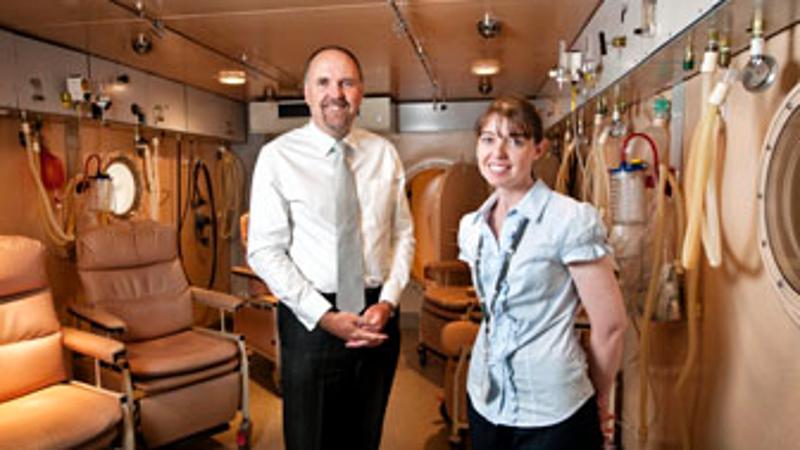
While many people associate hyperbaric chambers with scuba diving, the same technology is promising new hope for patients with chronic wounds.
Small-scale studies have already shown positive results. Now a research project being run jointly between Queensland University of Technology (QUT) and the Wesley Research Institute is seeking participants so that a larger evidence base can guide the way forward for medical practice in this area.
Principal investigator Dr Ken Thistlethwaite said hyperbaric oxygen treatment can help improve a body's ability to heal itself by increasing the amount of oxygen delivered to the affected area.
"Low oxygen tension develops around a chronic wound, which makes it more difficult for the body to heal itself. In this treatment, we dissolve 17 times the usual amount of oxygen into the patient's blood plasma, so when it travels through the capillaries, a higher concentration gradient allows the oxygen to diffuse further into the tissues," he said.
"It can improve a person's ability to combat infections and decrease swelling in the area."
Dr Thistlethwaite said that hyperbaric oxygen treatment had been used for treating wounds for quite a few years.
"While there is some evidence to support its use in diabetic foot infections, there isn't a lot of evidence to support its use in other areas, like venous wounds, which make up about 70 per cent of all wounds."
The research team are looking for people with venous leg ulcers to participate in this study, whether the person has had the condition for six weeks, or many years.
QUT wound researcher and nurse practitioner Michelle Gibb said a venous leg ulcer is a wound located on the lower leg and is associated with symptoms such as swelling.
"Participants in the study will receive gold standard treatments - dressings and bandages - free of charge, in the initial stage of the research," she said.
"If participants' wounds have not improved by at least 50 per cent within four weeks of gold standard treatments, they will then have the opportunity to undergo the hyperbaric oxygen treatment, also free of charge. Some participants will receive a placebo hyperbaric treatment."
Ms Gibb said that the purpose of this study was to determine the effectiveness of this type of treatment, as well as to indicate the most beneficial timing for treating patients.
"This is extremely valuable research. Wounds, which are largely an invisible problem, cost the health care system $500 million annually, and can cause sufferers a great deal of pain and loss of quality-of-life," Ms Gibb said.
"If hyperbaric oxygen therapy treatment is proven to speed up the rate of healing for venous leg ulcers, there are enormous benefits to the Australian and international community."
If you are interested to find out more about participating in the project, please contact research fellow Kathleen Finlayson on 07 3138 6105 or email: k.finlayson@qut.edu.au
This project is supported by the Wound Management Innovation Cooperative Research Centre.
RELATED ARTICLES
QUT technology offers remarkable healing touch
Diabetes wounds healed with oxygen under pressure
World-first $100 million health research centre opens
Media contact: Michaela Ryan, QUT media officer, 07 3138 4494 or michaela.ryan@qut.edu.au


